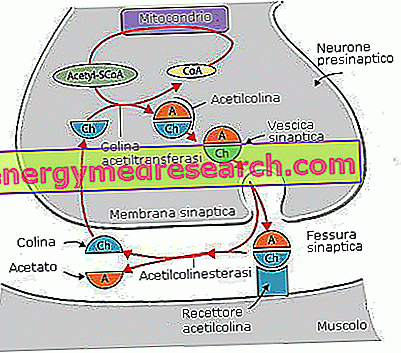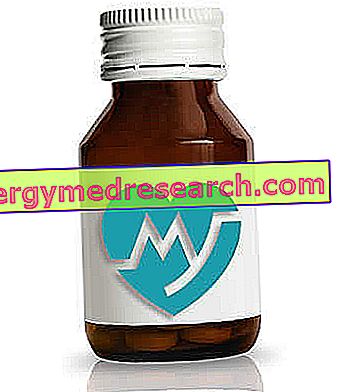Acetylcholine is a neurotransmitter, a substance produced by our body to transfer nerve impulses to multiple points in the central and peripheral nervous system. The neurons that secrete acetylcholine are called cholinergics; analogous speech for its receptors, which are distinguished in nicotinic and muscarinic receptors. The different concentration and chemical conformation of these receptors, and of the related isoforms in the tissues, means that the various drugs that interfere with the action of acetylcholine can produce effects that are prevalently limited to one sector rather than another. Despite this structural diversity, acetylcholine is able to bind to both receptors, since the part of the molecule that interacts with muscarinic receptors is different from the nicotinic receptors. This is one of the reasons why acetylcholine is not used directly for therapeutic purposes: since it acts on all of the body's cholinergic receptors (both muscarinic and nicotinic) its action is too widespread and not very specific.

Acetylcholine was the first neurotransmitter to be discovered, thanks to studies by Otto Loewi crowned in 1924. From the chemical point of view, acetylcholine is formed by the union of a choline molecule with one of acetyl-coenzyme A (acetyl -CoA); the first is a small molecule concentrated in the phospholipid membranes, while the Acetyl-CoA represents the metabolic intermediate between glycolysis and the Krebs cycle. The synthesis of acetylcholine from these two substances occurs along the axonal terminal; immediately after being synthesized, it is then stored in vesicles, which bind to the presynaptic membrane when a nervous impulse arrives, merging and releasing its contents by exocytosis. At this point the acetylcholine released in the synaptic cleft is free to reach the postsynaptic receptors and to interact with them, depolarizing the cell and giving way to the formation of an action potential in the nerve fiber or muscle fiber that has stimulated; immediately after this interaction, most of the acetylcholine is immediately degraded by acetylcholinesterase (ACHE). It is an enzyme placed near the cholinergic receptors, where it acts by breaking the bond between acetate and choline; the latter substance is readily reabsorbed by the presynaptic terminal and used for the synthesis of new acetylcholine (thanks to the enzyme choline-acetyltransferase). The action of this enzyme is very important, since it allows to interrupt the transmission of the nervous impulse.
Acetylcholine is the transmitter of all the nerves that control voluntary musculature (see neuromuscular plaque); however, although at this level it produces an excitatory effect, within the parasympathetic system it performs mainly inhibitory actions (most of the sympathetic neurons secrete epinephrine, while most of the parasympathetic neurons secretes acetylcholine). This molecule causes a slowing of the heart rate, while it stimulates the secretion of the bronchial, salivary, gastric and pancreatic glands, increasing intestinal peristalsis and generally all digestive functions. As well as at the level of the motive plates of the skeletal muscles, and of the post-ganglionic terminations of the parasympathetic nervous system, acetylcholine can be found at the level of synapses between pre-ganglionic fibers and post-ganglionic neurons of the sympathetic and parasympathetic nervous system, and of adrenal medulla, as well as in some synapses of the central nervous system.
The muscarinic actions correspond to those induced by the Acetylcholine released by the post-Ganglionic parasympathetic nerve endings, with two significant exceptions:
Acetylcholine causes a generalized vasodilation, although most of the vessels are not innervated by the parasympathetic system.
Acetylcholine causes secretion by the sweat glands, which are innervated by cholinergic fibers of the sympathetic nervous system.
Nicotinic actions correspond to those of acetylcholine released at the level of ganglionic synapses of sympathetic and parasympathetic systems, of the neuromuscular plaque of voluntary muscles and of nerve endings of splanchnic nerves surrounding the secretory cells of adrenal medulla.
As anticipated, effects similar to those of acetylcholine can be produced by substances capable of stimulating cholinergic receptors (parasympathomimetics) or blocking the action of acetylcholinesterase (anticholinesterase). In parallel, the effects of acetylcholine can be blocked by substances able to bind to cholinergic receptors, making them unavailable to pick up the signal transmitted by acetylcholine (anticholinergics). Let's look at some examples.
The curare causes death by muscular paralysis, blocking the action of acetylcholine on the muscular membranes (where nicotinic receptors are found); physostigmine, on the other hand, prolongs the action of acetylcholine by blocking cholinesterase, while the venom of the black widow stimulates an excess release. Nerve gases also block this enzyme, causing acetylcholine to remain anchored to its receptors; the lethal effect of these gases is useful for investigating the effects of the interaction between acetylcholine and its muscarinic receptors: cough, chest tightness, bronchial hypersecretion to pulmonary edema, nausea, vomiting, diarrhea, increased salivation, miosis and difficulty in vision, reduction in heart rate up to arrest and urinary incontinence. On the other hand, due to the accumulation of acetylcholine in nicotinic receptors, symptoms occur such as: skin pallor, tachycardia, arterial hypertension, hyperglycemia and alterations affecting the musculoskeletal system, particularly asthenia and easy muscle exhaustion, tremors and cramps. For the accumulation of acetylcholine the skeletal musculature can be paralyzed and death by muscle contraction paralysis may occur. Finally, the effects on the central nervous system include tonic-clonic contractions of epileptiform type, up to the depression of the respiratory centers and to death. This generally occurs due to asphyxia due to paralysis of the diaphragm and intercostal muscles. Botox, a poisonous toxin used in infinitesimal concentrations in aesthetic medicine, also has to do with acetylcholine; in fact, with its action, it prevents its release from the vesicles. In this way, the Botox causes a flaccid paralysis of the muscles, becoming deadly when it heavily involves the respiratory ones; in this sense it is opposed to the action of tetanus, characterized by spastic paralysis which is however independent of acetylcholine. Pilocarpine, a drug used mainly in ophthalmology to narrow the pupil and stimulate the lacrimation of the eye (useful in the treatment of glaucoma) is a muscarinic agonist; in fact it binds to muscarinic acetylcholine receptors. In this sense, pilocarpine counteracts the action of atropine, which is instead a muscarinic antagonist and as such inhibits the activity of the parasympathetic (parasympatholytic). Atropine blocks muscarinic receptors, while curare blocks nicotinic receptors.



